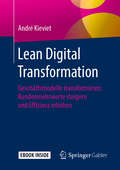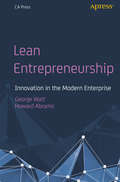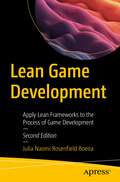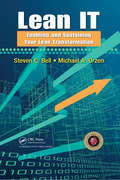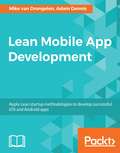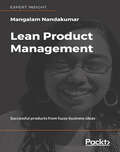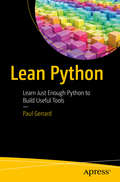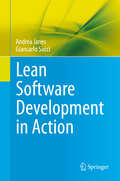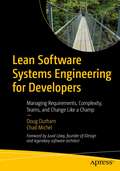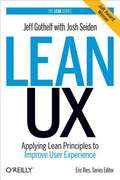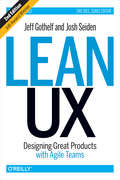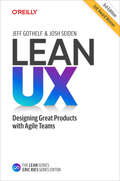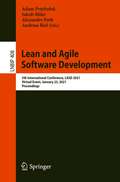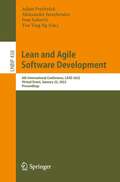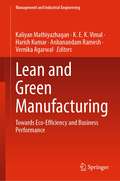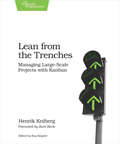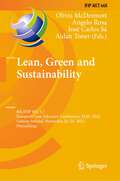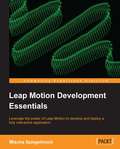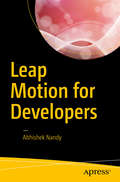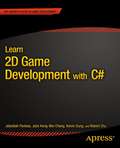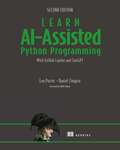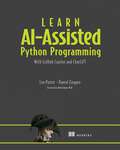- Table View
- List View
Lean Digital Transformation: Geschäftsmodelle transformieren, Kundenmehrwerte steigern und Effizienz erhöhen
by André KievietLernen Sie mit diesem Buch, wie Sie Prozesse der Lean Digital Transformation erfolgreich umsetzenMit seinem Buch „Lean Digital Transformation“ zeigt André Kieviet, dass die Umsetzung digitaler Strukturen innerhalb größerer Organisationen keine unlösbare Aufgabe ist. Finden Sie heraus, wie Sie die Möglichkeiten der Digitalisierung für Unternehmen nutzen können. Ein situatives Ordnungsschema unterstützt Sie bei der Frage nach relevanten, technologischen Werkzeugen.Methodisches Wissen und Praxisempfehlungen stehen im FokusZunächst beantwortet der Autor die grundlegenden Fragen „Was ist Digitalisierung und warum gibt es gerade jetzt diesen Hype?“. Auf diese Weise wird Ihnen dieses Konzept verständlich erläutert. Anschließend widmet sich Kieviet dem pragmatischen Ansatz der Lean Digital Transformation. Der Begriff „Lean“ wurde von ihm bewusst gewählt und beleuchtet zwei Perspektiven:Lean steht für Einfachheit: Firmen sollten nicht digitalisieren, nur um sich einem aktuellen Trend unterzuordnen. Vielmehr geht es um die zielorientierte Nutzung von Informationen mit maschineller Hilfe.Lean steht für das Konzept des Lean Managements: Durch den absoluten Fokus auf den Kundenmehrwert soll jegliche Form der Verschwendung im Rahmen des digitalen Umbruchs reduziert werden.André Kieviet führt diese beiden Dimensionen zusammen. Durch diesen pragmatischen, sowie anhand von Beratungsprojekten entwickelten Ansatz, eignen Sie sich nicht nur neues, methodisches Wissen an. Gleichzeitig dient Ihnen dieses Werk als Praxisleitfaden, mit dem Sie neue Anwendungsfelder der Digitalisierung sowie anwendbare Technologien für Ihr Unternehmen entdecken. Auf diese Weise sind Sie in der Lage, die digitalen Transformationsprozesse von Geschäftsmodellen, Unternehmenskultur oder der Mitarbeiterkommunikation selbst zu meistern – ideal für Praktiker, Unternehmer sowie Berater.
Lean Entrepreneurship: Innovation In The Modern Enterprise
by George Watt Howard AbramsUtilize this comprehensive guide in your organization to create a corporate incubator that protects innovative ideas from oppressive corporate processes and culture and gives those ideas the resources and environment they need to grow and have the best possible chance to thrive. Innovation is hard. Ironically, innovation in a large enterprise can be even more difficult. Policies designed for mature businesses often crush emerging businesses along with the entrepreneurial spirit of the innovators. Procedures can make it difficult, even impossible, for innovative employees to get their ideas funded, or even seen. As a result, even companies with their roots in innovation can find themselves unable to innovate, with a devastating impact on employee morale and often resulting in the exodus of the most creative employees. In Lean Intrapreneurship the authors leverage decades of personal experience innovating in large enterprises to explore the root causes of failure to innovate in established organizations, and offer a solution to the innovator’s dilemma. The book includes a recipe for creating a repeatable program for innovating in large organizations, including tools, tips, and strategies developed by the authors as they created an innovative incubation program for a multi-billion-dollar technology company. It also offers a wealth of information to help aspiring intrapreneurs and entrepreneurs bring their ideas to life. What You’ll LearnDiscover the most common reasons that innovation fails in established organizationsExplore techniques to make innovative ideas a successFollow a recipe to create a program to enable innovation across your companyUnderstand the power of transparency inside and outside an incubatorDevelop employees and foster a culture of innovation across your company Who This Book Is For Anyone with an innovative idea who wants to make it real but does not know where to begin; anyone struggling to innovate inside an established company; anyone who wishes to make their existing company more lean, agile, and efficient; anyone who wishes to start a program to incubate new, innovative ideas inside an established company
Lean Game Development: Apply Lean Frameworks to the Process of Game Development
by Julia Naomi Rosenfield BoeiraMaster Lean UX and Lean Startup techniques to improve your agile game development experience beyond Scrum. This updated version of the book focuses on applying lean and agile methodologies to the game development process and features improved examples, applied techniques, and a whole new section explaining how to test a game in Unity with CI. You'll see how to define a minimum viable product (MVP) for games with Lean Canvas, allowing customers to iterate over it and collect feedback for improvement at every cycle. All of these are achieved while still using standard Agile techniques. The first part of the book explains the ideation process of a game and how lean methodologies allow developers, especially small studios, to avoid scope creep. Next, it it provides guidance on creating MVPs and using player feedback to iterate and improve games. The book then discusses continual improvement (CI) methods. A crucial part of CI is generation of Lean Canvas. Lean Game Development, Second Edition shows you how to iterate until you develop a game that satisfies developers, gamers, and your studio's financial goals.What You'll LearnStudy lean and agile methodologies to enhance the game development process Find out how to improve the way game productions define value and iterate over itApply development strategies to enrich the game development processWho This Book Is ForPeople from all sectors of the gaming industry will find the book useful in planning their project in a more iterative way, unloading the management burden on the development process and collecting feedback to improve the game content as early as possible.
Lean IT: Enabling and Sustaining Your Lean Transformation
by Steven C Bell Michael A OrzenWinner of a Shingo Research and Professional Publication AwardInformation Technology is supposed to enable business performance and innovation, improve service levels, manage change, and maintain quality and stability, all while steadily reducing operating costs. Yet when an enterprise begins a Lean transformation, too often the IT department is ei
Lean Mobile App Development
by Alberto Gonzalez Mike Van Drongelen Adam Dennis Richard Garabedian Aravind KrishnaswamyDevelop lean iOS and Android apps using industry standard techniques and lean development practices. About This Book • Build ready-to-deploy apps with less iterations and shorter development times • Adopt the lean startup methodologies to develop iOS and Android apps that shine in the App Store • This hands-on guide puts continuous innovation into practice to develop successful mobile apps Who This Book Is For This book is for developers, CTOs, and architects working for a startup or another kind of lean startup environment, such as start-up within a cooperation. It is is ideal for any iOS and Android developer who wants to build successful mobile apps by adopting the lean startup methodology. What You Will Learn • Apply the lean startup methodology to real Android and iOS development • Define what your hypotheses are by creating an Minimal Viable Product • Validate your idea against the Business Model Canvas • Gather feedback through statistics and by getting user comments, learn from it, and adapt your app accordingly • Develop skills and devise strategies to build versatile and flexible apps that meet changing business requirements • Investigate the possibilities when you need to pivot your start-up idea whether in a startup or an established business. • Create a successful app and get tips on how to boostconversion and how to optimize the on boardingprocess. In Detail Lean is the ultimate methodology for creating a startup that succeeds. Sounds great from a theoretical point of view, but what does that mean for you as an a technical co-founder or mobile developer? By applying the Lean Start-up methodology to your mobile App development, it will become so much easier to build apps that take Google Play or the App Store by storm. This book shows you how to bring together smarter business processes with technical know-how. It makes no sense to develop a brilliant app for six months or longer only to find out later that nobody is interested in it. Build a Minimum Viable Product (MVP) first. Validate your hypotheses early and often. Discover effective product development strategies that let you put Facebook's famous axiom "move fast and break things" into practice. A great app without visibility and marketing clout is nothing, so use this book to market your app, making use of effective metrics that help you track and iterate all aspects of project performance. Style and approach This book takes a hands-on approach to developing apps through the Lean Start-up Methodology. Following a 50% business and 50% tech approach, this book is filled with practical examples and real-world experiments.
Lean Out: The Struggle For Gender Equality In Tech And Start-up Culture
by Elissa ShevinskyWhy aren't the great, qualified women already in tech being hired or promoted? Should people who don't fit in seek to join an institution that is actively hostile to them? Does the tech industry deserve women leaders? The split between the stated ideals of the corporate elite and the reality of working life for women in the tech industry--whether in large public tech companies or VC-backed start-ups, in anonymous gaming forums, or in Silicon Valley or Alley--seems designed to crush women's spirits. Corporate manifestos by women who already fit in (or who are able to convincingly fake it) aren't helping. There is a high cost for the generation of young women and transgender people currently navigating the harsh realities of the tech industry, who gave themselves to their careers only to be ignored, harassed and disrespected. Not everyone can be a CEO; not everyone is able to embrace a workplace culture that diminishes the contributions of women and ignores real complaints. The very culture of high tech, where foosball tables and endless supplies of beer are de facto perks, but maternity leave and breast-feeding stations are controversial, is designed to appeal to young men. Lean Out collects 25 stories from the modern tech industry, from people who fought GamerGate and from women and transgender artists who have made their own games, from women who have started their own companies and who have worked for some of the most successful corporations in America, from LGBTQ women, from women of color, from transgender people and people who do not ascribe to a gender. All are fed up with the glacial pace of cultural change in America's tech industry. Included are essays by anna anthropy, Leigh Alexander, Sunny Allen, Lauren Bacon, Katherine Cross, Dom DeGuzman, FAKEGRIMLOCK, Krys Freeman, Gesche Haas, Ash Huang, Erica Joy, Jenni Lee, Katy Levinson, Melanie Moore, Leanne Pittsford, Brook Shelley, Elissa Shevinsky, Erica Swallow, and Squinky. Edited and selected by entrepreneur and tech veteran Elissa Shevinsky, Lean Out sees a possible way forward that uses tech and creative disengagement to jettison 20th century corporate culture: ''I've figured out a way to create safe space for myself in tech,'' writes Shevinsky. ''I've left Silicon Valley, and now work remotely from home. I adore everyone on my team, because I hired them myself.
Lean Product Management: Successful products from fuzzy business ideas
by Mangalam NandakumarA guide to product management exploring the best practices: identifying the impact-driven product, planning for success, setting up and measuring time-bound metrics, and developing a lean product roadmap.Key FeaturesIdentifying Impact-Driven ProductsInvesting in Key Business OutcomesValue mapping to maintain a lean product backlogUtilizing time-bound product metricsEliminating process wasteBook DescriptionLean Product Management is about finding the smartest way to build an Impact Driven Product that can deliver value to customers and meet business outcomes when operating under internal and external constraints. Author, Mangalam Nandakumar, is a product management expert, with over 17 years of experience in the field. Businesses today are competing to innovate. Cost is no longer the constraint, execution is. It is essential for any business to harness whatever competitive advantage they can, and it is absolutely vital to deliver the best customer experience possible. The opportunities for creating impact are there, but product managers have to improvise on their strategy every day in order to capitalize on them. This is the Agile battleground, where you need to stay Lean and be able to respond to abstract feedback from an ever shifting market. This is where Lean Product Management will help you thrive. Lean Product Management is an essential guide for product managers, and to anyone embarking on a new product development. Mangalam Nandakumar will help you to align your product strategy with business outcomes and customer impact. She introduces the concept of investing in Key Business Outcomes as part of the product strategy in order to provide an objective metric about which product idea and strategy to pursue. You will learn how to create impactful end-to-end product experiences by engaging stakeholders and reacting to external feedback. What you will learnHow do you execute ideas that matter?How can you define the right success metrics?How can you plan for product success?How do you capture qualitative and quantitative insights about the product? How do you know whether your product aligns to desired business goals?What processes are slowing you down?Who this book is forIf you are leading a team that is building a new product, then this book is for you. The book is targeted at product managers, functional leads in enterprises, business sponsors venturing into new product offerings, product development teams, and start-up founders.
Lean Python
by Paul GerrardLearn only the essential aspects of Python without cluttering up your mind with features you may never use. This compact book is not a "best way to write code" type of book; rather, the author goes over his most-used functions, which are all you need to know as a beginner and some way beyond. Lean Python takes 58 Python methods and functions and whittles them down to 15: as author Paul Gerrard says, "I haven't found a need for the rest. " What You'll Learn Discover lean Python and how to learn just enough to build useful tools Use Python objects, program structure, I/O, modules and more Handle errors and exceptions Test your code Access the Web; do searching; and persist data Who This Book Is For This book is aimed at three categories of reader: The experienced programmer - if you already know a programming language, this book gives you a shortcut to understanding the Python language and some of its design philosophy. You work in IT and need a programming primer - you might be a tester who needs to have more informed technical discussions with programmers. Working through the examples will help you to appreciate the challenge of good programming. First-timer - you want a first book on programming that you can assimilate quickly to help you decide whether programming is for you.
Lean Six Sigma Secrets for the CIO
by Peter T. Davis William BentleyGoing beyond the usual how-to guide, Lean Six Sigma Secrets for the CIO supplies proven tips and valuable case studies that illustrate how to combine Six Sigma's rigorous quality principles with Lean methods for uncovering and eliminating waste in IT processes. Using these methods, the text explains how to take an approach that is all about im
Lean Six Sigma im Bankensektor: Operative und strategische Anwendungen für Theorie und Praxis
by Vijaya Sunder M L. S. GaneshDieses Buch untersucht eine Reihe möglicher Wege, Modelle sowie operativer und strategischer Ansätze für Lean Six Sigma (LSS), eine zeitgemäße Praxis der kontinuierlichen Verbesserung (CI) zur Erzielung eines qualitätsbasierten Wettbewerbsvorteils in Organisationen. Fallstudien von Lean-Six-Sigma-Projekten in Bankunternehmen helfen, die operativen Dimensionen von LSS zu veranschaulichen, während die hier vorgestellten fallspezifischen und fallübergreifenden Analysen den strategischen Wert von LSS demonstrieren. Die Falldaten, die zur Gewinnung der Erkenntnisse herangezogen wurden, stammen zwar aus dem Bankensektor, ermöglichen jedoch eine Verallgemeinerung über den Bank- und Finanzdienstleistungssektor hinaus.Das Buch vertritt die Auffassung, dass LSS nicht nur eine KI-Praxis ist, sondern eine übergeordnete organisatorische Fähigkeit, genauer gesagt eine dynamische Fähigkeit, die es Unternehmen ermöglicht, einen auf Qualität basierenden Wettbewerbsvorteil zu erzielen. Das Buch richtet sich an Praktiker und Forscher gleichermaßen und schafft ein Gleichgewicht zwischen Theorie und Praxis.Für Praktiker bietet es einen Leitfaden für den Einsatz von LSS zur Erzielung von Wettbewerbsvorteilen und für evidenzbasierte Praktiken im Qualitätsmanagement und der operativen Exzellenz. Für Wissenschaftler stellt es eine Fülle von Literatur vor und erweitert den Wissensschatz zum Qualitätsmanagement. Dementsprechend ist das Buch sowohl für Praktiker als auch für Forscher von unschätzbarem Wert, da es ersteren hilft, den Wert von LSS sowohl als operative als auch als strategische Ressource zu erschließen, und letzteren potenzielle Forschungsrichtungen und Anwendungen aufzeigt."Dieses Buch vermittelt ein tiefes Verständnis der Lean Six Sigma-Anwendungen. Es inspiriert, indem es die Prinzipien des Konzepts auf ungewöhnliche Bereiche von Betrieb und Management jenseits des üblichen Qualitäts- und Projektmanagements überträgt. Beim Lesen des Buches kam mir die großartige Idee, Lean Six Sigma auch in meinem digitalen Unternehmenanzuwenden. Am Ende des Buches hatte ich den Eindruck, dass die Möglichkeiten für den richtigen Einsatz von Lean Six Sigma grenzenlos sind, insbesondere wenn man es aus der Perspektive der dynamischen Fähigkeiten betrachtet. Die Leser dieses Buches werden sicherlich Einblicke in die Verbesserung ihrer Geschäftsprozesse sowohl in operativer als auch in strategischer Hinsicht erhalten. Obwohl sich das Buch auf den Bankensektor konzentriert, eignet es sich eigentlich für ein sehr breites Publikum. Es handelt sich um eine brillante Forschungsarbeit und ein Buch, das als Leitfaden für die Transformation durch das Prisma von Lean Six Sigma dienen wird."- Professorin. Dr. ZornitsaYordanova, Leitende Assistenzprofessorin für Innovationsmanagement, Universität für nationale und internationale Wirtschaft, Sofia, Bulgarien"Lean Six Sigma muss aus einer Systemperspektive heraus verstanden werden, undes besteht eine große Wissenslücke in diesem Bereich, wenn es darum geht, ganzheitliche Lösungen für Geschäftsprobleme zu finden. Dieses Buch ist ein sehr willkommenes Werk, das diese Forderung aufgreift. Es integriert die Ressourcen des Qualitätsmanagements und die Sichtweise der dynamischen Fähigkeiten in die Praxis. Der Bereich Banken und Finanzdienstleistungen wurde passend gewählt, da er für Sozialunternehmen am unmittelbarsten anwendbar ist. Jeder, der mit weniger Mitteln mehr Wirkung erzielen möchte, wird von der Lektüre dieses Buches profitieren.-Alex Abraham, Hauptgeschäftsführer, Lean Success Partners, Winnipeg, Manitoba, Kanada"Das Buch ist eine erfrischende Bereicherung für die Welt des Qualitätsmanagements, insbesondere im Kontext von Banken und Finanzdienstleistungen. Konzepte und Begriffe wie "Schnelligkeit von Lean & Robustheit von Six Sigma zur Lösung operativer Probleme" "Hybride Methodik" passen sehr gut zu dem, was wir heute in der Branche tun.Ein weiterer interessanter Aspekt des Buches ist die Anwendung des "Dynamic Capabilities"-Ansatze
Lean Software Development in Action
by Giancarlo Succi Andrea JanesThis book illustrates how goal-oriented, automated measurement can be used to create Lean organizations and to facilitate the development of Lean software, while also demonstrating the practical implementation of Lean software development by combining tried and trusted tools. In order to be successful, a Lean orientation of software development has to go hand in hand with a company's overall business strategy. To achieve this, two interrelated aspects require special attention: measurement and experience management. In this book, Janes and Succi provide the necessary knowledge to establish "Lean software company thinking," while also exploiting the latest approaches to software measurement. A comprehensive, company-wide measurement approach is exactly what companies need in order to align their activities to the demands of their stakeholders, to their business strategy, etc. With the automatic, non-invasive measurement approach proposed in this book, even small and medium-sized enterprises that do not have the resources to introduce heavyweight processes will be able to make their software development processes considerably more Lean. The book is divided into three parts. Part I, "Motivation for Lean Software Development," explains just what "Lean Production" means, why it can be advantageous to apply Lean concepts to software engineering, and which existing approaches are best suited to achieving this. Part II, "The Pillars of Lean Software Development," presents the tools needed to achieve Lean software development: Non-invasive Measurement, the Goal Question Metric approach, and the Experience Factory. Finally, Part III, "Lean Software Development in Action," shows how different tools can be combined to enable Lean Thinking in software development. The book primarily addresses the needs of all those working in the field of software engineering who want to understand how to establish an efficient and effective software development process. This group includes developers, managers, and students pursuing an M. Sc. degree in software engineering.
Lean Software Systems Engineering for Developers: Managing Requirements, Complexity, Teams, and Change Like a Champ
by Doug Durham Chad MichelGraduate to the next level of your software development career, learning the tools you need to successfully manage the complexity of modern software systems.Whether you are a developer at a small software company, or one of many developers at a large enterprise, your success directly correlates to the ability of your development team to rapidly respond to change. What makes this task challenging in today’s world, is that the technical challenges we as developers strive to overcome are becoming increasingly more complex. We have to consider many more options when it comes to things like requirements, solution hosting, support, pace of change, and generally with less time and warning.A good developer knows that it is critical to manage every aspect of software development from soup to nuts, and understands that when details and decisions are left to chance, outcomes can be negatively impacted. Poor planning can result in increased errors, substandard quality, budget and schedule overruns, and result in the ultimate business failure, dissatisfied customers, and stakeholders.This book will help you put on the lenses of a software engineer. You will come away with an understanding of how to view the entire spectrum of the software development process, learn valuable concepts, and apply these principles through meaningful examples, case studies, and source code. What You Will LearnMove beyond being a programmer to being a professional software engineerSpend more time doing software development; minimize time spent dealing with ineffective or inadequate processesReduce errors in judgment and provide predictable outcomes, while still maintaining agility and responsiveness using Lean and Agile practicesKnow the steps you can take to ensure a shared understanding among stakeholdersDiscover tools to validate user experience early and often to minimize costly re-workDevelop software designs and architectures that enable long-term business agilityImplement patterns and processes that result in “falling into the pit of success” instead of into the “pit of failure”Adopt processes and patterns that will result in pervasive “institutionalized” qualityUnderstand the necessity of redefining the essential role of technical leadership to ensure team maturity and growth Who This Book Is ForSoftware developers and team leaders who have struggled to implement design and development best practices due to lack of team resources, in-depth knowledge, or experience, and want a book designed to provide the confidence and foundational skills needed to achieve success
Lean UX: Applying Lean Principles to Improve User Experience
by Jeff Gothelf Josh Seiden<p>The Lean UX approach to interaction design is tailor-made for today’s web-driven reality. In this insightful book, leading advocate Jeff Gothelf teaches you valuable Lean UX principles, tactics, and techniques from the ground up—how to rapidly experiment with design ideas, validate them with real users, and continually adjust your design based on what you learn.</p>
Lean UX: Designing Great Products with Agile Teams
by Jeff Gothelf Josh SeidenUX design has traditionally been deliverables-based. Wireframes, site maps, flow diagrams, content inventories, taxonomies, mockups helped define the practice in its infancy.Over time, however, this deliverables-heavy process has put UX designers in the deliverables business. Many are now measured and compensated for the depth and breadth of their deliverables instead of the quality and success of the experiences they design. Designers have become documentation subject matter experts, known for the quality of the documents they create instead of the end-state experiences being designed and developed.So what's to be done? This practical book provides a roadmap and set of practices and principles that will help you keep your focus on the the experience back, rather than the deliverables.Get a tactical understanding of how to successfully integrate Lean and UX/DesignFind new material on business modeling and outcomes to help teams work more strategicallyDelve into the new chapter on experiment designTake advantage of updated examples and case studies
Lean UX: Designing Great Products with Agile Teams
by Jeff Gothelf Josh SeidenLean UX is synonymous with modern product design and development. By combining human-centric design, agile ways of working, and a strong business sense, designers, product managers, developers, and scrum masters around the world are making Lean UX the leading approach for digital product teams today.In the third edition of this award-winning book, authors Jeff Gothelf and Josh Seiden help you focus on the product experience rather than deliverables. You'll learn tactics for integrating user experience design, product discovery, agile methods, and product management. And you'll discover how to drive your design in short, iterative cycles to assess what works best for businesses and users. Lean UX guides you through this change--for the better.Facilitate the Lean UX process with your team with the Lean UX CanvasEnsure every project starts with clear customer-centric success criteriaUnderstand the role of designer on an agile teamWrite and contribute design and experiment stories to the backlogEnsure that design work takes place in every sprintBuild product discovery into your team's "velocity"
Lean and Agile Software Development: 5th International Conference, LASD 2021, Virtual Event, January 23, 2021, Proceedings (Lecture Notes in Business Information Processing #408)
by Alexander Poth Adam Przybyłek Jakub Miler Andreas RielThis book constitutes the proceedings of the 5th International Conference on Lean and Agile Software Development, LASD 2021, which was held online on January 23, 2021. The conference received a total of 32 submissions, of which 10 full and 2 short papers are included in this volume. In addition, one keynote paper is also included. To live the agile mindset, the LASD conference focuses on highly relevant research outcomes and fosters their way into practice. Topics discussed in this volume range from teams under COVID-19 through women in Agile, to product road-mapping and non-functional requirements.
Lean and Agile Software Development: 6th International Conference, LASD 2022, Virtual Event, January 22, 2022, Proceedings (Lecture Notes in Business Information Processing #438)
by Adam Przybyłek Aleksander Jarzębowicz Ivan Luković Yen Ying NgThis book constitutes the proceedings of the 6th International Conference on Lean and Agile Software Development, LASD 2022, which was held online on January 22, 2022. The conference received a total of 29 submissions, of which 9 full papers, 1 short paper and 1 position paper are included in this volume. In addition, the volume contains one keynote paper in full paper length. Topics discussed in this volume cover various aspects of agile software development and range from agile testing, to agile effort estimation, an agile approach to model-driven development, and remotely working agile teams.
Lean and Green Manufacturing: Towards Eco-Efficiency and Business Performance (Management and Industrial Engineering)
by Harish Kumar Kaliyan Mathiyazhagan K. E. K. Vimal Anbanandam Ramesh Vernika AgarwalThis book provides a stage-by-stage integration of lean and green manufacturing paradigms to achieve environmental and economic benefits. The book includes chapters on conceptual development for incorporating the lean and green paradigm, and methods, tools and techniques for developing and integrating lean manufacturing. Several case studies which demonstrate the benefits of integrating lean and green manufacturing techniques are also covered here. The contents of this book are expected to support researchers and practitioners in the implementation of integrated lean and green manufacturing technologies.
Lean from the Trenches: Managing Large-Scale Projects with Kanban
by Henrik KnibergYou know the Agile and Lean development buzzwords, you've read the books. But when systems need a serious overhaul, you need to see how it works in real life, with real situations and people. Lean from the Trenches is all about actual practice. Every key point is illustrated with a photo or diagram, and anecdotes bring you inside the project as you discover why and how one organization modernized its workplace in record time.Lean from the Trenches is all about actual practice.Find out how the Swedish police combined XP, Scrum, and Kanban in a 60-person project. From start to finish, you'll see how to deliver a successful product using Lean principles. We start with an organization in desperate need of a new way of doing things and finish with a group of sixty, all working in sync to develop a scalable, complex system. You'll walk through the project step by step, from customer engagement, to the daily "cocktail party," version control, bug tracking, and release. In this honest look at what works--and what doesn't--you'll find out how to:Make quality everyone's business, not just the testers.Keep everyone moving in the same direction without micromanagement.Use simple and powerful metrics to aid in planning and process improvement.Balance between low-level feature focus and high-level system focus.You'll be ready to jump into the trenches and streamline your own development process.
Lean, Green and Sustainability: 8th IFIP WG 5.7 European Lean Educator Conference, ELEC 2022, Galway, Ireland, November 22–24, 2022, Proceedings (IFIP Advances in Information and Communication Technology #668)
by Olivia McDermott Angelo Rosa José Carlos Sá Aidan TonerThis book constitutes the refereed proceedings of the 8th European Lean Educator Conference ELEC 2022, which took place in Galway, Ireland, in November 2022; the event was sponsored by IFIP WG 5.7. The 28 full papers presented were carefully reviewed and selected for inclusion in the proceedings. They are organized in the following thematic sections: Lean & People; Lean in Healthcare; Lean 4.0; Lean in Manufacturing; Lean Learning in the Digital Era; Lean, Green & Sustainability; and Lean in Services.
Leap Motion Development Essentials
by Mischa SpiegelmockThis book is a fast-paced guide with practical examples that aims to help you understand and master the Leap Motion SDK.This book is for developers who are either involved in game development or who are looking to utilize Leap Motion technology in order to create brand new user interaction experiences to distinguish their products from the mass market. You should be comfortable with high-level languages and object-oriented development concepts in order to get the most out of this book.
Leap Motion for Developers
by Abhishek NandyDevelop apps and games using the Leap Motion sensor. This book starts with a brief introduction to Leap Motion, then covers getting the Leap Motion working and setting up a Leap Motion development environment. Leap Motion for Developers also covers the life cycle of how you interact with Leap Motion and the workflow of making a complete app. You'll see how to use different programming languages for simple and steady development. The next part of the book walks through the basics of Leap Motion with Python and Java. We will then work on using Leap Motion with Unity, where we will build an app using Unity and then add different functionality to it. In the last part we cover Unreal 4, Processing, and JavaScript for Leap Motion. What You Will Learn Look at the basics of Leap Motion Develop apps for the Leap Motion sensor See how different languages work with Leap Motion Discover the future of Leap Motion Who This Book Is For Students, developers, game developers, and tech enthusiasts.
Learn 2D Game Development with C#
by Jebediah Pavleas Jack Keng-Wei Chang Kelvin Sung Robert Zhu2D games are hugely popular across a wide range of platforms and the ideal place to start if you're new to game development. With Learn 2D Game Development with C#, you'll learn your way around the universal building blocks of game development, and how to put them together to create a real working game. C# is increasingly becoming the language of choice for new game developers. Productive and easier to learn than C++, C# lets you get your games working quickly and safely without worrying about tricky low-level details like memory management. This book uses MonoGame, an open source framework that's powerful, free to use and easy to handle, to further reduce low-level details, meaning you can concentrate on the most interesting and universal aspects of a game development: frame, camera, objects and particles, sprites, and the logic and simple physics that determines how they interact. In each chapter, you'll explore one of these key elements of game development in the context of a working game, learn how to implement the example for yourself, and integrate it into your own game library. At the end of the book, you'll put everything you've learned together to build your first full working game! And what's more, MonoGame is designed for maximum cross-platform support, so once you've mastered the fundamentals in this book, you'll be ready to explore and publish games on a wide range of platforms including Windows 8, MAC OSX, Windows Phone, iOS, Android, and Playstation Mobile. Whether you're starting a new hobby or considering a career in game development, Learn 2D Game Development with C# is the ideal place to start. What you'll learn Know your way around the world of game design and the process of designing a game from scratch. Understand the basic architecture of a 2D game engine and develop your own game library. Work with the MonoGame framework and use it to build your own 2D interactive games. Learn and implement simple in-game pseudo autonomous behaviors. Understand and implement the math and physics underlying realistic game interactions. Give your game impact with graphic effects, and audio and special effects. Who this book is for This book is perfect for game enthusiasts, hobbyists, and anyone who is interested in building interactive games but is unsure of how to begin. It assumes no background in computer graphics or game development, but readers should be familiar with C# or another object-oriented language. Table of Contents Introducing 2D Game Development in C# Getting to Know the MonoGame Framework 2D Graphics, Coordinates, and Game State Getting Things Moving Pixel-Accurate Collisions Game Object States and Semiautonomous Behaviors Sprites, Camera, Action! Particle Systems Building Your First 2D Game
Learn AI-Assisted Python Programming, Second Edition
by Daniel Zingaro Leo PorterSee how an AI assistant can bring your ideas to life immediately!Once, to be a programmer you had to write every line of code yourself. Now tools like GitHub Copilot can instantly generate working programs based on your description in plain English. An instant bestseller, Learn AI-Assisted Python Programming has taught thousands of aspiring programmers how to write Python the easy way—with the help of AI. It&’s perfect for beginners, or anyone who&’s struggled with the steep learning curve of traditional programming. In Learn AI-Assisted Python Programming, Second Edition you&’ll learn how to: • Write fun and useful Python applications—no programming experience required! • Use the GitHub Copilot AI coding assistant to create Python programs • Write prompts that tell Copilot exactly what to do • Read Python code and understand what it does • Test your programs to make sure they work the way you want them to • Fix code with prompt engineering or human tweaks • Apply Python creatively to help out on the job AI moves fast, and so the new edition of Learn AI-Assisted Python Programming, Second Edition is fully updated to take advantage of the latest models and AI coding tools. Written by two esteemed computer science university professors, it teaches you everything you need to start programming Python in an AI-first world. You&’ll learn skills you can use to create working apps for data analysis, automating tedious tasks, and even video games. Plus, in this new edition, you&’ll find groundbreaking techniques for breaking down big software projects into smaller tasks AI can easily achieve. Foreword by Beth Simon. About the technology The way people write computer programs has changed forever. Using GitHub Copilot, you describe in plain English what you want your program to do, and the AI generates it instantly. About the book This book shows you how to create and improve Python programs using AI—even if you&’ve never written a line of computer code before. Spend less time on the slow, low-level programming details and instead learn how an AI assistant can bring your ideas to life immediately. As you go, you&’ll even learn enough of the Python language to understand and improve what your AI assistant creates. What's inside • Prompts for working code • Tweak code manually and with AI help • AI-test your programs • Let AI handle tedious details About the reader If you can move files around on your computer and install new programs, you can learn to write useful software! About the author Dr. Leo Porter is a Teaching Professor at UC San Diego. Dr. Daniel Zingaro is an Associate Teaching Professor at the University of Toronto. The technical editor on this book was Peter Morgan. Table of Contents 1 Introducing AI-assisted programming with GitHub Copilot 2 Getting started with Copilot 3 Designing functions 4 Reading Python code: Part 1 5 Reading Python code: Part 2 6 Testing and prompt engineering 7 Problem decomposition 8 Debugging and better understanding your code 9 Automating tedious tasks 10 Making some games 11 Creating an authorship identification program 12 Future directions
Learn AI-assisted Python Programming: With GitHub Copilot and ChatGPT
by Leo PorterWriting computer programs in Python just got a lot easier! Use AI-assisted coding tools like GitHub Copilot and ChatGPT to turn your ideas into applications faster than ever.AI has changed the way we write computer programs. With tools like Copilot and ChatGPT, you can describe what you want in plain English, and watch your AI assistant generate the code right before your eyes. It&’s perfect for beginners, or anyone who&’s struggled with the steep learning curve of traditional programming. In Learn AI-Assisted Python Programming: With GitHub Copilot and ChatGPT you&’ll learn how to: Write fun and useful Python applications—no programming experience required! Use the Copilot AI coding assistant to create Python programs Write prompts that tell Copilot exactly what to do Read Python code and understand what it does Test your programs to make sure they work the way you want them to Fix code with prompt engineering or human tweaks Apply Python creatively to help out on the job Learn AI-Assisted Python Programming: With GitHub Copilot and ChatGPT is a hands-on beginner&’s guide that is written by two esteemed computer science university professors. It teaches you everything you need to start programming Python in an AI-first world. You&’ll hit the ground running, writing prompts that tell your AI-assistant exactly what you want your programs to do. Along the way, you&’ll pick up the essentials of Python programming and practice the higher-level thinking you&’ll need to create working apps for data analysis, automating tedious tasks, and even video games. Foreword by Beth Simon, Ph.D. About the technology The way people write computer programs has changed forever. Using GitHub Copilot, you describe in plain English what you want your program to do, and the AI generates it instantly. About the book This book shows you how to create and improve Python programs using AI—even if you&’ve never written a line of computer code before. Spend less time on the slow, low-level programming details and instead learn how an AI assistant can bring your ideas to life immediately. As you go, you&’ll even learn enough of the Python language to understand and improve what your AI assistant creates. What's inside Prompts for working code Tweak code manually and with AI help AI-test your programs Let AI handle tedious details About the reader If you can move files around on your computer and install new programs, you can learn to write useful software! About the author Dr. Leo Porter is a Teaching Professor at UC San Diego. Dr. Daniel Zingaro is an Associate Teaching Professor at the University of Toronto. The technical editor on this book was Peter Morgan. Table of Contents 1 Introducing AI-assisted programming with Copilot 2 Getting started with Copilot 3 Designing functions 4 Reading Python code – Part 1 5 Reading Python Code – Part 2 6 Testing and prompt engineering 7 Problem decomposition 8 Debugging and better understanding your code 9 Automating tedious tasks 10 Making some games 11 Future directions
